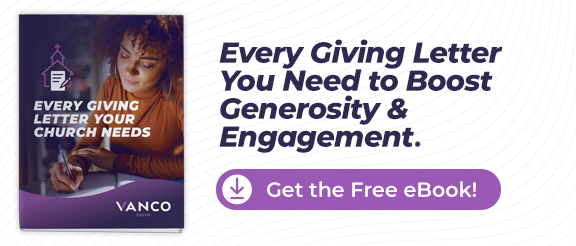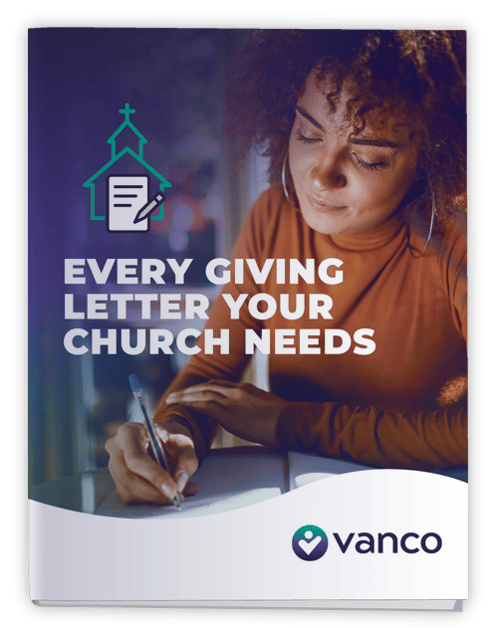 Believe it or not, 32 percent of non-profit funding actually comes from government grants. Aside from those funds, there's always money sitting in private grants as well.
Believe it or not, 32 percent of non-profit funding actually comes from government grants. Aside from those funds, there's always money sitting in private grants as well.
Churches have access to these grants, but it's not as simple as submitting a church resume and hoping for the best. Writing a proposal for funding a church project requires knowledge about grant writing and technical writing in general.
If you don't have a grant writer at your disposal, then don't worry! We've got a guide to help you learn exactly how you can write the best church proposal you can.
- What Is a Grant Proposal?
- Components of a Church Funding Proposal
- 8 Tips for Writing a Grant Proposal
- Sample Proposal for Funding a Church Project
- 35 Giving and Thank You Letter Templates for Every Church Occasion
What Is a Grant Proposal?
Proposals, in technical terms, are the answer to requests for proposals (or RFPs). RFPs are basically just announcements saying that a group is accepting proposals for something.
These RFPs can be for different things, but in this context, they'll be specifically for grants. A proposal is a response you'll send in, and there are very specific things you'll need to include.
Proposals are highly technical documents that consist of 8 different parts that you need to include: a cover letter, an executive summary, a statement of need, goals and objectives, methods and strategies, a plan of evaluation, budget information and an organizational background.
If you're looking for some other ways you can raise funding, check out these practical ministry funding impact strategies.
These are very exact pieces to the proposal puzzle, and you'll want a section dedicated to each individual piece. You can see what this looks like in the sample section later on.
Components of a Church Funding Proposal
Cover Letter
Cover letters are an important part of any proposal, and you've probably written a few in your lifetime. They don't change too much, and the concept of them stays the same whether you're applying for a job or a grant.
You should include a brief summary of what's contained in your proposal. Remember, this is where you'll make your first impression to whatever group is distributing the grant; make it good!
Because of just how brief this should be, you may want to wait until the end to write it. That way you'll have a big picture and a review of everything you've done. Just remember to keep it as short as you can.
Typically, the most important things you'll want to focus on in the cover letter include the mission of your church and how the grant will allow you to do that. You'll also want to include any requirements the grant needs and how your church fulfills them.
Executive Summary
The executive summary is the place to expand on what you wrote about in your cover letter. However, you'll want to keep this pretty precise as well.
There are a few key things to include. First, you need to explain how your project is going to be positive and is needed within your community. Think of this as a time to show your passion for the project you're raising money for.
Next, you'll want to include why your church is the group that should be running the project. Think about the various members of your group and how you have the time and management skills to get your project done well.
Lastly, make it clear how the funder would support your specific project. You want to be explicit with how you'll use the grant in a way that the funders would support. With church grants, this is an easier thing to do.
You should also show a brief overview of the budget and your plan for execution. Remember to keep the executive summary concise and precise! Oftentimes, funders will look at the executive summary and decide on reading the rest of your proposal, so make it count.
Statement of Need
Similar to the way it sounds, the statement of need portion will explain the problem that you're looking to solve with the grant money. Typically, this is about a page long and goes in-depth about the problem in your community.
If you're looking to write about building a building, then take a look at this building donation article for some tips on how to write effectively.
Be careful; a major problem in this section is coming off too negative. You want to make the problem sound urgent, but you don't want to make it seem like too big of a task or something that needs more than the grant can give.
Try to deduce the problem down as much as possible. You'll want to clearly explain what's going on, the history of your community in this context and provide metrics to back up your claims.
Goals and Objectives
This is a straightforward section, but there are some tips and tricks to help your proposal for funding a church project.
These are your quantitative goals, meaning the things you want to accomplish that you can actually measure. You can use immeasurable goals as well, but make sure to break them down into metrics you can report on.
The most important thing to remember is that your goals and objectives should work together and match the funder's goal.
Methods and Strategies
This is typically the longest section of your proposal. The methods and church strategies section is where you'll provide a deep-dive solution to the problem you've created earlier on in your document.
You can describe every step that you'll take along the way, the people that are going to be involved, and even any software you'll use. You don't want the funder to have any questions about your method at the end of this section.
One thing to keep in mind is to tie everything back to your original goal. You don't want to digress and lose sight of the reason why you're doing your project (which is the same reason a potential funder wants to fund you).
Plan of Evaluation
This section is where you'll actually outline a measurable way to evaluate the work you do with the grant money as you go. This should be detailed with dates (or week/month numbers), and the funders should be able to check in on your progress according to this plan.
This is also where you'll want to include any information about your organization or plan that's required by the funder.
While this can be a tedious process, it's a great way to show accountability while also creating a plan that you can follow if you do get the grant money. It's a lot of upfront planning, but it will pay off in the end.
Budget Information
The key to the budget information part of your proposal is to be as detailed as possible while also being as simple as possible. You don't want to overwhelm the funder as they read, but you want to provide as much information as possible.
You can make things simpler to understand with formatting. Use a mix of graphs, text and bullets. Clear headers are also important, and using the white space on your page is necessary.
The most important thing you want to show on this end is how your project is going to sustain itself after the grant. You can use projected income, like tithes and donations, to show how you won't need additional grant money. This can be easier if you're just trying to build something, but if you're creating a program, then this can be much more difficult.
Organizational Background
The organization background is the place for you to talk about your church! The funder wants to know about the organization he or she is giving money to, so it's important to shed some light on yourself.
You should discuss the history of your church as well as any major changes the church has been through. You'll also want to talk about the projects your church is currently doing, or major things the church has done in the past. Tapping into the memories of some of the older members in your congregation can help you get interesting views on past events.
There should also be information on the leaders of the church, including the pastor/s, deacons and elders. You'll also want to include basic membership information, such as numbers and demographic information. If you plan on getting anyone else involved, like contractors, then you'll need to include them as well.
There are some other key numbers you might want to include here, but many churches don't actually keep these metrics.
8 Tips for Writing Proposals
These tips and tricks below can help you with some of the more difficult writing aspects of proposals. There's also some information that can save you headaches down the road.
1. Start With an Outline
One of the best things you can do when you write anything is to create an outline. Outlines are even more important with proposals because you have a lot of stuff you're trying to include in a complex document.
The best part is the beginning of the outline is already done for you! You can start with each of the sections we talked about above, from the cover letter to the organizational background.
Once you've got everything laid out, you can start filling in the blanks. This helps while you do research as well; you can put it in the appropriate part of your outline. This can help you stay organized so that your proposal is organized and clear, too!
The University of Southern California has a great guide to using and creating outlines here.
2. Take Your Time
Don't rush anything when it comes to writing or planning your proposal. You'll want to dedicate plenty of time to actually writing the proposal. For most people, writing doesn't come easily. You'll need time and an app like Grammarly to keep you on track as you write so that you can write well.
Even when you're done, spend a good amount of time on proofreading and editing. As a general rule, you'll spend more time editing than you will on writing. You can use other people to read over the proposal and see how things flow. You can make changes to the structure of each section easily once it's written.
3. Include Every Detail You Can Think of
When it comes to details in your proposal, you really can't have too many as long as they're in the right place. The funder wants to see that you're going to accomplish your goal, and the more details you have, the better you can prove yourself.
4. Be as Clear as Possible
After everything we've discussed, it's no secret that proposals are complex documents. They contain a ton of information, and it's very easy to get overwhelmed by all the detailed data.
You want to prevent the funder from getting overwhelmed, and you'll need to be thinking about that when you work through each section. One tip to help with this is being as clear and concise as you can in a main point then breaking the point down into smaller more detailed ideas underneath.
Make sure that each section of your proposal is clear by itself. Sometimes funders will go to a specific section to read, and you don't want him or her to be confused because that section relied on previous-mentioned facts.
5. Include Everything the Grant Asks for
Sometimes the request for proposals (or RFPs) will ask you to include specific information on your proposal. This can be anything from a special timeline or even guidelines on what kinds of projects the grant will fund.
No matter what the information is, make sure to explicitly include it in the proposal. Don't just assume that the funder will know when your proposal is within their guidelines, make sure you state it somewhere in your proposal.
Sometimes RFPs will request certain documents or information about your church in the proposal, and it's important to have that information sent in at the same time. Even if you don't have the information required, find a way to get it and submit your proposal with it. Without it, you don't stand a chance.
6. Include Alternate Options and Why You're Not Choosing Them
There's typically never a "one answer" solution for any given problem. There are always going to be alternative solutions, and sometimes those solutions could be cheaper.
One thing to realize is that a funder wants to see these different solutions, even if you've ruled them out. You need to include them in your details while you explain your plan, and you want to explain why you didn't choose that option.
This also shows your responsibility for the project. The more solutions you come up with that are potentially viable, the more you look like you've thought through your own solution. You'll look more professional and serious, and it's a way to stand out from the competition.
7. Get Help if You Need It
Don't be afraid to get help if you need it when you're writing your proposal. No one is an expert at writing proposals without training.
There are plenty of ways you can seek help. First, you can ask the people you care about if they have any knowledge of grant writing and would be willing to help you. This can be family members or other members of your congregation. Even people that have great writing skills and grammatical talents can help you out.
You can even hire companies or freelanceres to help you. However, you'll want to try keeping it within your church; the more familiar the writer is with your church, the better the writing will be in general.
The biggest way you can get help is by letting those near you proofread the proposal. You'll be able to tell how clear and how well-written your proposal is by getting feedback from someone who isn't involved with writing the proposal itself. Sometimes this can be exactly what you need when you're formatting your proposal.
8. Show It to People Outside of the Church
Once you've shown it to the people closest to you, you can branch out and show it to any acquaintances you have that aren't part of your church.
This might sound counter-productive, but it's a great way to see how well your proposal holds up. While church grants are typically given by groups that are led by faith, you still want your project to hold up in front of those outside of the church.
You can get valuable feedback about your executive summary this way; anyone in the community can benefit from church programs, and it's a great way to see just how impactful your reasoning for a program can be.
Sample Proposal for Funding a Church Project
The important thing to realize when you're writing to fund a church project is that, in the grand scheme of things, churches aren't applying for a lot of grants. A lot of churches don't realize grants exist. That means the more you can stand out, the better you'll do.
You can use these PDF templates for starting your proposal. However, they aren't going to be as structured and well-done as the proposal you can create by following the instructions above.
It's important that you can create a well-rounded proposal that hits every topic we discussed above. Just because other churches are using easy-to-use templates doesn't mean you should. In fact, you can get a better idea of what a proposal should look like by looking at the best of the best in any kind of industry.
While some of the sections are named a bit differently, you can use this sample PDF from Western Carolina University to get a good idea of what your proposal should look like and how it should be structured.
Further Funding Ideas
Writing a proposal for funding a church project is a great way to raise money, but it's not the only way. Tithes and other donations make up a huge part of church funding.
Vanco Faith is the perfect way to allow your congregation and other people to donate to your church online. We have a variety of tools that will allow people to easily fund your church, and we offer endless support.
Ready to talk more? Schedule a free demo here, and we'll find the best way to help your church.
35 Giving and Thank You Letter Templates for Every Church Occasion
Without a framework, or an example, crafting an appeal or a thank-you message can be cumbersome. That's why we built a complete guide that not only offers 35 letter samples and templates for nearly any situation, but also offers specific guidelines to help.











